Invertebrates
The most common animals on a heathland are invertebrates. This group includes insects and spiders. They rely on the structure provided by the soil and vegetation to nest and feed. Many also require the warmth that is made available by sunlight reaching the ground. Invertebrates have very particular requirements and are therefore sensitive to changes in their habitat. A few of the invertebrates found on heathland are described below:
 Silver studded blue butterflies are on the wing in July and August where they flit around heathy rides and other areas of short heather. Their green caterpillars have a very close relationship with certain species of ant which provide protection in exchange for sugary secretions.
Silver studded blue butterflies are on the wing in July and August where they flit around heathy rides and other areas of short heather. Their green caterpillars have a very close relationship with certain species of ant which provide protection in exchange for sugary secretions.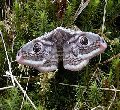 The Emperor moth is one of the largest moths found in the UK. They, and many other species, feed on heather plants as caterpillars.
The Emperor moth is one of the largest moths found in the UK. They, and many other species, feed on heather plants as caterpillars.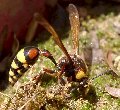 Potter wasps build tiny pots from mud and sand on heather stems in which to lay eggs. The wasp collects food from the heath and places it in the pot for the larvae to feed on.
Potter wasps build tiny pots from mud and sand on heather stems in which to lay eggs. The wasp collects food from the heath and places it in the pot for the larvae to feed on.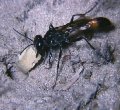 Sand wasps burrow into the hard sand at the edge of paths. They are solitary wasps, so they do not create hives and nests.
Sand wasps burrow into the hard sand at the edge of paths. They are solitary wasps, so they do not create hives and nests.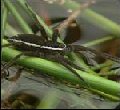 Many spiders rely on plants like gorse and heather to build their webs. Their webs are best seen in the morning when covered in dew. The Raft spider is the UK’s largest spider and hunts prey in bogs by resting its front legs on the water and feeling for the presence of underwater insects and even small fish.
Many spiders rely on plants like gorse and heather to build their webs. Their webs are best seen in the morning when covered in dew. The Raft spider is the UK’s largest spider and hunts prey in bogs by resting its front legs on the water and feeling for the presence of underwater insects and even small fish.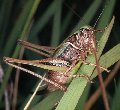 Bog bush crickets are grasshopper-like insects which eat purple moor grass in wet areas of heath. They are recognised by their long antennae and U-shaped light mark at the side of their head.
Bog bush crickets are grasshopper-like insects which eat purple moor grass in wet areas of heath. They are recognised by their long antennae and U-shaped light mark at the side of their head.